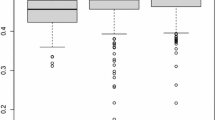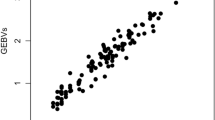Abstract
This study seeks to quantify the importance of epistatic effects on the heterosis of maize using complex pedigrees in a single model of the so-called bi-, tri-, and tetra-alleles in an analysis with and without information from microsatellite markers. To this end, 51 inbred lines were sampled from different backgrounds, obtaining 6 double cross hybrids, 14 triple cross hybrids, and 58 single cross hybrids, for a total of 78 hybrids. Seventy-nine microsatellite markers were used in the genoty** of the 51 lines. These markers were distributed throughout the 10 linkage groups in maize. This information was used to construct an information matrix on kinship. The mixed models and restricted maximum likelihood approaches were used to estimate additive, dominant and epistatic effects. It was observed that the dominant by dominant epistasis was the most important effect related to genetic control of the heterosis in maize. Also, our study demonstrated that it is possible to exploit a large amount of information when we jointly analyze simple, double, and three-way cross hybrids under the same model. Using this approach, it is possible to dissect heterosis into several components and to adopt the best crossbreeding strategy based on the importance of each component. Additionally, it was possible to verify that the use of molecular markers improves the accuracy of calculating the epistatic and dominance effects. Thus, using the current state-of-art in quantitative genetics and statistical methods the concept of crossbreeding can be expanded to frontiers that are far beyond the traditional general and specific combining ability.




Similar content being viewed by others
References
Balestre M, Machado JC, Lima JL, Souza JC, Filho LN (2008) Genetics distances estimates among single cross hybrids and correlation with specific combining ability and yield in maize double cross hybrids. Genet Mol Res 7:65–73
Balestre M, Von Pinho RG, Souza CL Jr, Bueno Filho JSS (2012) Bayesian map** of multiple traits in maize: the importance of pleiotropic effects in studying the inheritance of quantitative traits. Theor Appl Genet 125:479–493
Bueno Filho JSS, Gilmour SG (2003) Planning incomplete block experiments when treatments are genetically related. Biometrics 59:375–381
Carlborg O, Haley CS (2004) Epistasis: too often neglected in complex trait studies? Nat Rev Genet 5:618–625
Cockerham CC (1961) Implications of genetic variances in a hybrid breeding program. Crop Sci 1:47–52
Cockerham CC (1980) Random and fixed effects in plant genetics. Theor Appl Genet 56:119–131
Cockerham CC, Zeng ZB (1996) Design III with marker loci. Genetics 143:437–1456
Ferreira DV, Von Pinho RG, Balestre M, Oliveira RL (2010) Prediction of maize hybrid performance using similarity in state and similarity by descent information. Genet Mol Res 9:2381–2394
Frascaroli E, Canè MA, Landi P, Pea G, Gianfranceschi L, Villa M, Morgante M, Pè ME (2007) Classical genetic and quantitative trait loci analyses of heterosis in a maize hybrid between two elite inbred lines. Genetics 176:625–644
Garcia AA, Wang S, Melchinger AE, Zeng ZB (2008) Quantitative trait map** and the genetic basis of heterosis in maize and rice. Genetics 180:1707–1724
Henderson CR (2008) Applications of liner models in animal breeding. University of Guelph Press, Guelph
Hill WG, Goddard ME, Visscher PM (2008) Data and theory point to mainly additive genetic variance for complex traits. PLoS Genet 4:1–10
Hochholdinger F, Hoecker N (2007) Towards the molecular basis of Heterosis. Trends Plant Sci 12:427–432
Hua J, **ng Y, Wu W et al (2003) Single-locus heterotic effects and dominance by dominance interactions can adequately explain the genetic basis of heterosis in an elite rice hybrid. PNAS 100:2574–2579
Jordan DR, Tao YZ, Godwin ID, Henzell RG, Cooper M, McIntyre CL (2004) Comparison of identity by descent and identity by state for detecting genetic regions under selection in a sorghum pedigree breeding program. Mol Breed 14:441–454
Larièpe A, Mangin B, Jasson S et al (2012) The genetic basis of heterosis: multiparental quantitative trait loci map** reveals contrasted levels of apparent overdominance among traits of agronomical interest in maize (Zea mays L.). Genetics 190:795–811
Lu H, Romero-Severson J, Bernardo R (2003) Genetics basis of heterosis explored by simple sequence repeat markers in a random-mated maize population. Theor Appl Genet 107:494–502
Mackay TF, Stone EA, Ayroles JF (2009) The genetics of quantitative traits: challenges and prospects. Nat Rev Genet 10:565–577
Melchinger AE, Utz HF, Piepho HP, Zeng ZB, Schön CC (2007) The role of epistasis in the manifestation of heterosis: a systems-oriented approach. Genetics 177:1815–1825
Mrode RA, Thompson R (2005) Linear models for the prediction of animal breeding values, 2nd edn. CABI Publishing, New York
Powers L (1944) An expansion of Jones’ theory for the explanation of heterosis. Am Nat 78:275–280
Rawlings J, Cockerham CC (1962a) Analysis of double cross hybrid populations. Biometrics 18(229):244
Rawlings J, Cockerham CC (1962b) Triallel analysis. Crop Sci 2:228–231
Riedelsheimer C, Czedik-Eysenberg A, Grieder C, Lisec J, Technow F, Sulpice R, Altmann T, Stitt M, Willmitzer L, Melchinger AE (2012) Genomic and metabolic prediction of complex heterotic traits in hybrid maize. Nat Genet 44:217–220
Roso VM, Schenkel FS, Miller SP, Schaeffer LR (2005) Estimation of genetic effects in the presence of multicollinearity in multibreed beef cattle evaluation. J Anim Sci 83:1788–1800
Schnell FW, Cockerham CC (1992) Multiplicative vs. arbitrary gene action in heterosis. Genetics 131:461–469
Schön CC, Dhillon BS, Utz HF, Melchinger AE (2010) High congruency of QTL positions for heterosis of grain yield in three crosses of maize. Theor Appl Genet 120:321–332
Troyer AF (2006) Adaptedness and heterosis in maize and mule hybrids. Crop Sci 46:528–543
Van Der Veen JH (1959) Tests of non-allelic interaction and linkage for quantitative characters in generations derived from two diploid pure lines. Genetica 30:201–232
Zeng ZB, Wang T, Zou W (2005) Modeling quantitative trait loci and interpretation of models. Genetics 169:1711–1725
Acknowledgments
To Advanta Seeds for supporting this research and to the Brazilian funding agency (FAPEMIG) for conceding a research grant for the last author. Comments of both reviewers were very insightful and made this a better paper.
Author information
Authors and Affiliations
Corresponding author
Appendix
Appendix
Using the genetic model it is possible to recovery the inter-genotypic information in disconnected blocks. For instance, to consider four hybrids (two single cross, one double cross and three-way cross) allocated in two different blocks. In the block 1 we have allocated the hybrids 1x2 and 1x3. On the other hand, the double cross hybrid (1x2) x (3x4) and the three-way cross (1x3)x2 were allocated in the block 2. Using traditional analysis (ANOVA), the contrasts among these hybrids are not estimable and the treatments, in theory, are not comparable. However, using Bayesian approach or likelihood inference by mixed models as used in this work, we can deal with this problem using a genetic model under complex pedigree (Bueno Filho and Gilmour 2003). Thus, we have four parental involved in the crosses instead four hybrids and six possible dominant effects to be estimated. The design matrix for blocks, additive and dominant effects are given below. In order to simplify the epistatic effects were omitted. Details about X, Z1 and Z2 are given in the model (9).
X | Z1 | Z2 | |||||||||
|---|---|---|---|---|---|---|---|---|---|---|---|
β1 | β2 | a1 | a2 | a3 | a4 | d12 | d13 | d14 | d23 | d24 | d34 |
1 | 0 | 1 | 1 | 0 | 0 | 1 | 0 | 0 | 0 | 0 | 0 |
1 | 0 | 0 | 0 | 1 | 1 | 0 | 0 | 0 | 1 | 0 | 0 |
0 | 1 | 0.5 | 0.5 | 0.5 | 0.5 | 0 | 0.25 | 0.25 | 0 | 0.25 | 0.25 |
0 | 1 | 0.5 | 1 | 0.5 | 0 | 0.5 | 0 | 0 | 0.5 | 0 | 0 |
It is evident that instead to use the hybrids model and using the pedigree model we can link all genetic effects distributed in all blocks (Bueno Filho and Gilmour 2003). Concatenating Z1 and Z2 and assuming θ as the vector for random effects in the model (9), the solution for θ is given by:
where β* is the OLS estimator for blocks effects given by \( \left( {X^{T} X} \right)^{ - 1} X^{T} y.\) In the mixed models equation the matrices Z TX or \( X^{T} Z \) are matrices of incidence of the genetics effects in each block whose result is (in the current example) given by:
X TZ1 | X TZ2 | ||||||||
|---|---|---|---|---|---|---|---|---|---|
1 | 1 | 1 | 1 | 1 | 0 | 0 | 1 | 0 | 0 |
1 | 1.5 | 1 | 0.5 | 0.5 | 0.25 | 0.25 | 0.5 | 0.25 | 0.25 |
In this matrix we can observe that all additive effects are present in both blocks. However, only two dominant effects are present in the block 1. This matrix can be renamed as N, and the matrix \( \left( {X^{T} X} \right) \) as K—the block size matrix. Using this new notation the solution for random effects is given by:
Whose matrix \( N^{T} K^{ - 1} N \) is given by:
1 | 1.25 | 1 | 0.75 | 0.75 | 0.125 | 0.125 | 0.75 | 0.125 | 0.125 |
1.25 | 1.625 | 1.25 | 0.875 | 0.875 | 0.1875 | 0.1875 | 0.875 | 0.1875 | 0.1875 |
1 | 1.25 | 1 | 0.75 | 0.75 | 0.125 | 0.125 | 0.75 | 0.125 | 0.125 |
0.75 | 0.875 | 0.75 | 0.625 | 0.625 | 0.0625 | 0.0625 | 0.625 | 0.0625 | 0.0625 |
0.75 | 0.875 | 0.75 | 0.625 | 0.625 | 0.0625 | 0.0625 | 0.625 | 0.0625 | 0.0625 |
0.125 | 0.1875 | 0.125 | 0.0625 | 0.0625 | 0.03125 | 0.03125 | 0.0625 | 0.03125 | 0.03125 |
0.125 | 0.1875 | 0.125 | 0.0625 | 0.0625 | 0.03125 | 0.03125 | 0.0625 | 0.03125 | 0.03125 |
0.75 | 0.875 | 0.75 | 0.625 | 0.625 | 0.0625 | 0.0625 | 0.625 | 0.0625 | 0.0625 |
0.125 | 0.1875 | 0.125 | 0.0625 | 0.0625 | 0.03125 | 0.03125 | 0.0625 | 0.03125 | 0.03125 |
0.125 | 0.1875 | 0.125 | 0.0625 | 0.0625 | 0.03125 | 0.03125 | 0.0625 | 0.03125 | 0.03125 |
If so, we can recover the inter-genotypic information in different hybrids randomized in disconnected blocks making all genetics effects comparable by use of the complete matrix \( N^{T} K^{ - 1} N. \) While in traditional analysis of incomplete block design the recovery of (inter-block) information is obtained by taking genotypes as fixed and blocks as random, in this work we used the blocks as fixed and genotypes as random making all genetics effects comparable and linked as previously showed by Bueno Filho and Gilmour (2003).
Rights and permissions
About this article
Cite this article
Melo, W.M.C., Balestre, M., Von Pinho, R.G. et al. Genetic control of the performance of maize hybrids using complex pedigrees and microsatellite markers. Euphytica 195, 331–344 (2014). https://doi.org/10.1007/s10681-013-0999-7
Received:
Accepted:
Published:
Issue Date:
DOI: https://doi.org/10.1007/s10681-013-0999-7




